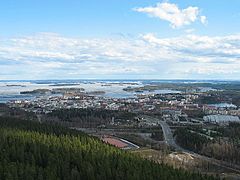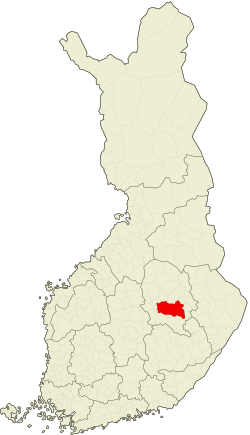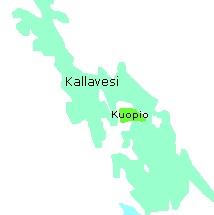User:Joan de Sa Bardissa/sandbox
Joan de Sa Bardissa/sandbox | |
|---|---|
City | |
 Kuopio viewed from the Puijo Tower | |
 | |
| Coordinates: 62°53′33″N 027°40′42″E / 62.89250°N 27.67833°E | |
| Country | |
| Region | Northern Savonia |
| Sub-region | Kuopio sub-region |
| Settled | 1653 |
| Charter | 1775 |
| Government | |
| • City manager | Petteri Paronen |
| • Density | 0/km2 (0/sq mi) |
| Time zone | UTC+02:00 (EET) |
| • Summer (DST) | UTC+03:00 (EEST) |
| Postal code | FI-70100 |
| Website | www.kuopio.fi |
Kuopio és una ciutat i municipi a la regió de la Savònia del Nord, ''Pohjois Savo'' en finès. Amb una població de 124,021[6] fa que sigui la 9a ciutat més poblada de Finlàndia. La superfície total de la ciutat és de 4,326.35 square kilometres (1,670.41 sq mi), dels quals 719.85 km2 (277.94 sq mi) són aigua[2] i la meitat són boscos. La densitat de població és només de 38/km2 (98/sq mi), però l'àrea metropolitana és densament poblada (urban area: 1 617.6 /km²[7]), i ocupa el 2n lloc a nivell nacional, just després de la capital Helsinki (urban area: 1,690.0/km²[7]).[8] La població total de la regió de Kuopio és de 119,472.[9]
Topònim[edit]
Hi ha diverses hipòtesis sobre l'origen del nom Kuopio. La primera es remunta al s. XVI, quan un personatge de gran influència anomenat Kauhanen a Tavinsalmi va canviar el seu nom per Skopa i la pronunciació de la gent era Coopia esdevenint després Cuopio. La segona explicació diu que el nom provindria del verb en finès kuopia, que vol dir, per exemple, quan un cavall grata el terra amb les seves peülles. La tercera història diu que el nom vindria d'un nom d'home propi de Carèlia Prokopij, de Ruokolahti a l'Edat Mitjana.[10] Aquesta darrera explicació semblar ser que és la més probable, ja que està documentada per l' Institut de Recerca per a les Llengües de Finlàndia.
Història[edit]
This section needs expansion. You can help by adding to it. (November 2011) |
Kuopio va ser fundada el 1653 pel governador Peter Brahe, malgrat que la data de fundació oficial reconeguda és el 17 de novembre de 1775, quan el rei Gustau III de Suècia va ordenar la creació de la ciutat de Kuopio. El municipi de Karttula es va afegir al de Kuopio el 2011,[11] tal com va fer Vehmersalmi el 2005, Riistavesi el 1973 i Kuopion maalaiskunta el 1969.

Geografia[edit]
La ciutat és envoltada pel llac Kallavesi, i molts d'indrets estan construïts en illes. Kuopio's ample waterfronts and islands are also utilized in the Saaristokaupunki (lit. Archipelago city) -project, the biggest residential area currently being built in Finland.[12] Saaristokaupunki will accommodate a total of 14,000 inhabitants in 2015. All houses will be situated no more than 500 metres (1,600 ft) from the nearest lakeshore.[13]
Transport[edit]
The city has a nationally unique feature in its street network, where every second street is practically a pedestrian and cycle street,[14] so called "rännikatu" (lit. rain gutter street). These streets provide pedestrians a calm environment aside from the main street traffic.[15] This setup dates back all the way to 1776 and the first town plan by Pehr Kjellman. Originally rännikatu, gränd (in Swedish) were created as a fire barrier to prevent a possible fire escalating in a city mostly built with wood.[16]
Transport connections to Kuopio include Pendolino trains and air service from Kuopio Airport with Finnair, Blue1 and Finncomm (domestic, to Helsinki-Vantaa
Educació i negocis[edit]
| University | Students |
|---|---|
| University of Eastern Finland | 6 229[17] |
| Savonia University of Applied Sciences | 5 000[18] |
| HUMAK University of Applied Sciences | ~150 |
| Sibelius Academy | ~100 |


Kuopio has always been a city of education. Some of the first schools offering education in Finnish (such as the School for the Blind in 1871, and the Trade School in 1887) were established in Kuopio. Currently the most important institutions are the University of Eastern Finland, the Savonia University of Applied Sciences, Vocational College of Northern Savonia and the Kuopio department of the Sibelius Academy.
Kuopio is known as a strong center of health (e.g. it has the biggest yearly enrollment rate of medical students in Finland), pharmacy, environment, food & nutrition (all legalized Clinical and Public Health Nutritionists in Finland graduate from the University of Eastern Finland), safety (education in Emergency Services is centered in Kuopio[19]) and welfare professions, as the major organisations University of Kuopio, Savonia University of Applied Sciences and Technopolis Kuopio are particularly oriented to those areas.

There are about 4,200 enterprises in Kuopio,[20] of which approximately 180 are export companies.[21] These provide about 45,000 jobs.[21]
Gent i cultura[edit]
Kuopio is known as the cultural center of Eastern Finland. A wide range of musical (from kindergarten to doctorate-level studies) and dance education is available and the cultural life is active. Notable events include ANTI – Contemporary Art Festival, Kuopio Dance Festival, Kuopio Rockcock, Kuopio Wine Festival and Finland Ice Marathon. A notable place, however, to enjoy the local flavor of Kuopio life and food is Sampo, a fish restaurant loved by locals and tourists as well.
Kuopio is known for its association with a national delicacy, Finnish fish pastry (Kalakukko), and the dialect of Savo, as well as the hill of Puijo and the Puijo tower. Besides being a very popular outdoor recreation area, Puijo serves also as a stage for a yearly World Cup ski jumping competition.
In Finland the inhabitants of Kuopio have a special reputation: they are known as jovial and verbally joking.[citation needed] Within the Savo culture, the onus is placed on the listener to interpret the story. People of Kuopio region and Eastern Finland have always had many health problems and the mortality has been higher than on an average in Finland. Because of this, Eastern Finland has been a sweetspot for Public Health studies. The North Karelia Project by the University of Kuopio in coordination with the National Public Health Institute and the World Health Organization, beginning in the 1970s was one of its first steps towards world class research.
During the 2000s (decade), Kuopio has placed very well in a number image, popularity and city-attractiveness surveys. In 2007 it was placed third, behind Tampere and Oulu.
Religió[edit]
The largest church of Finland, Evangelical Lutheran Church has a diocese in Kuopio, which is shepherded by bishop Wille Riekkinen.
Kuopio is home of the Finnish Orthodox Church where its primate, archbishop of Karelia and all Finland Leo (Makkonen) is seated. This is an autonomous cell within the autocephalous jurisdiction of the Patriarchate of Constantinople. It is the only mainstream Orthodox faction to celebrate Easter on the Latin date. The late Archbishop Paul had been successful in producing literature of popular theology.
The town is also home to the first Burmese Buddhist monastery in Finland, named the Buddha Dhamma Ramsi monastery.[22]
Clima[edit]
| Climate data for Kuopio | |||||||||||||
|---|---|---|---|---|---|---|---|---|---|---|---|---|---|
| Month | Jan | Feb | Mar | Apr | May | Jun | Jul | Aug | Sep | Oct | Nov | Dec | Year |
| Mean daily minimum °C (°F) | −13.2 (8.2) |
−13.4 (7.9) |
−8.3 (17.1) |
−2.8 (27.0) |
3.8 (38.8) |
10.4 (50.7) |
13.1 (55.6) |
11.3 (52.3) |
6.4 (43.5) |
1.5 (34.7) |
−4.5 (23.9) |
−10.3 (13.5) |
−0.5 (31.1) |
| Average precipitation mm (inches) | 41.2 (1.62) |
31.1 (1.22) |
34.2 (1.35) |
31.9 (1.26) |
38.8 (1.53) |
65.4 (2.57) |
76.9 (3.03) |
80.2 (3.16) |
58.6 (2.31) |
52.8 (2.08) |
51.1 (2.01) |
45.6 (1.80) |
607.8 (23.94) |
| Average precipitation days | 11 | 8 | 9 | 7 | 8 | 9 | 11 | 11 | 10 | 11 | 12 | 11 | 118 |
| Source: World Meteorological Organisation (UN) [23] | |||||||||||||
Personatges destacats[edit]
Esports a Kuopio[edit]
Kuopio bid for the 2012 Winter Youth Olympics, a youth sports festival in the tradition of the Olympics. It became a finalist in November 2008, but ultimately lost to Innsbruck, Austria. Kuopio's image as a small city with a large University and many active young people was considered a model of what the International Olympic Committee seeks for the Games.[24]
- KalPa (ice hockey)
- KuPS (football)
- Kuopion Taitoluistelijat (Figure Skating)
- Puijon Hiihtoseura (skiing, ski jumping, nordic combined, biathlon)
- Puijon Pesis (pesäpallo)
- Kuopion Reippaan voimistelijat (gymnastics)
- Finland Ice Marathon (ice skating event)
- Kuopio Steelers (american football)
Relacions internacionals[edit]
Agermanaments[edit]
Kuopio is twinned with:
References[edit]
- Notes
- ^ a b c d e f g h i j k l m n o p q r "Population growth biggest in nearly 70 years". Population structure. Statistics Finland. 2024-04-26. ISSN 1797-5395. Retrieved 2024-04-29.
- ^ a b c d e "Area of Finnish Municipalities 1.1.2018" (PDF). National Land Survey of Finland. Retrieved 30 January 2018.
- ^ "Key figures on population by region, 1990-2022". StatFin. Statistics Finland. Retrieved 28 October 2023.
- ^ a b "Luettelo kuntien ja seurakuntien tuloveroprosenteista vuonna 2023". Tax Administration of Finland. 14 November 2022. Retrieved 7 May 2023.
- ^ a b c d e "Population according to age (1-year) and sex by area and the regional division of each statistical reference year, 2003–2020". StatFin. Statistics Finland. Retrieved 2 May 2021.
- ^ Cite error: The named reference
population_countwas invoked but never defined (see the help page). - ^ a b "Taajamissa asuu 84 prosenttia väestöstä". Statistics Finland. 15 January 2008. Retrieved 7 January 2009.
- ^ Kuopio 2015: Jalankulku-, joukkoliikenne- ja autokaupunki. Finland’s Ministry of the Environment. p. 42. ISBN 978-952-11-2852-3.
- ^ Kuopion Kaupunkilehti, 19 March 2008, bottom of page 4)
- ^ [1][dead link]
- ^ "Karttula sulautuu Kuopioon" & "Karttula ja Kuopio yhteen". Savon Sanomat. 1 July 2008. pp. 1 and 3.
{{cite news}}: More than one of|work=and|newspaper=specified (help) - ^ "Kuopion korkein asuinkerrostalo nousi harjakorkeuteen". Suomen Kiinteistölehti. 2008-10-16. p. 14.
- ^ "Kallaveden syleilyssä". Saaristokaupunki. Kuopio. Retrieved 7 January 2009.
- ^ WP2: Accessibility, Synthesis Report (PDF). Universell utforming. 26 March 2004. p. 14.
- ^ Description of the Case Areas (PDF). VTT Technical Research Centre of Finland. 2 May 2002. p. 8.
- ^ "Napoleon ja Kuopio: Kuninkaiden Kuopio". Memory of Northern Savonia. Museums of Northern Savonia. Retrieved 11 January 2009.
- ^ "Key Data for 2007". University of Kuopio. 2007. Retrieved 9 January 2009.
- ^ "In English". Savonia University of Applied Sciences. 2009. Retrieved 9 January 2009.
- ^ Emergency Services College
- ^ Kuopion työpaikat ja elinkeinorakenne 1.1.2008 (PDF). Kuopion kaupungin yrityspalvelu. 2008. pp. 1–2.
- ^ a b "Elinkeinoelämä". City of Kuopio. 7 October 2008. Retrieved 9 January 2009.
- ^ "Buddhist Channel | Buddhism News, Headlines | World | Burmese Buddhist monastery opens in Finland". Buddhistchannel.tv. 2009-01-05. Retrieved 2011-09-16.
- ^ "World Weather Information Service – Kuopio". United Nations. Retrieved 21 January 2011.
- ^ Innsbruck and Kuopio Make Final Shortlist For 2012 Youth Olympic Winter Games
- ^ "List of Twin Towns in the Ruhr District" (PDF). © 2009 Twins2010.com. Retrieved 2009-10-28.
{{cite web}}: External link in|publisher= - ^ "Opole Official Website – Twin Towns".

 (in English and Polish) © 2007–2009 Urząd Miasta Opola. Retrieved 2009-06-18.
(in English and Polish) © 2007–2009 Urząd Miasta Opola. Retrieved 2009-06-18.
External links[edit]
- City of Kuopio – Official website (in Finnish, Swedish, English, and German)
- KuopioInfo – Various resources about different areas of interest related to Kuopio History and Life (in Finnish, English, German, Russian, and Chinese)
- 360° panorama of Kuopio Marketplace
- Savonia University of Applied Sciences (in English)
- University of Eastern Finland (in English)
- Technopolis Kuopio (in Finnish, English, and Russian)
- Invest in Kuopio -factsheet (in English)
- Satellite picture by Google Maps
Category:Cities and towns in Finland Category:Municipalities of Northern Savonia Region



